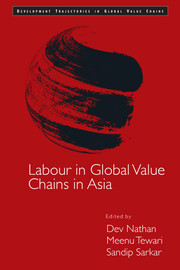Book contents
- Frontmatter
- Contents
- Figures
- Tables
- Foreword
- Preface
- Acknowledgements
- Introduction
- Captive Governance
- 2 Achieving Better Work for Apparel Workers in Asia
- 3 Improving Wages and Working Conditions in the Bangladesh Garment Sector: The Role of Horizontal and Vertical Relations
- 4 Bargaining in Garment GVCs: The Asia Floor Wage
- 5 Fresh Produce Markets, Standards, and Dynamics of Labour: Grapes in India
- 6 The ‘Zero-Fee’ Tour: Price Competition and Chain Downgrading in Chinese Tourism
- 7 Restricting Competition to Reduce Poverty: Impact of the Tourism Value Chain in an Upland Economy in China
- 8 Restructuring of Post-crisis GVCs: Tourism in Bali, Indonesia
- 9 Dynamics of Labour-intensive Clusters in China: Wage Costs and Moving Inland
- 10 Migrant Labour in Global Value Chains in Asia
- Modular Governance
- Relational Governance
- Conclusions
- Notes on Contributors
- Index
10 - Migrant Labour in Global Value Chains in Asia
from Captive Governance
Published online by Cambridge University Press: 23 July 2017
- Frontmatter
- Contents
- Figures
- Tables
- Foreword
- Preface
- Acknowledgements
- Introduction
- Captive Governance
- 2 Achieving Better Work for Apparel Workers in Asia
- 3 Improving Wages and Working Conditions in the Bangladesh Garment Sector: The Role of Horizontal and Vertical Relations
- 4 Bargaining in Garment GVCs: The Asia Floor Wage
- 5 Fresh Produce Markets, Standards, and Dynamics of Labour: Grapes in India
- 6 The ‘Zero-Fee’ Tour: Price Competition and Chain Downgrading in Chinese Tourism
- 7 Restricting Competition to Reduce Poverty: Impact of the Tourism Value Chain in an Upland Economy in China
- 8 Restructuring of Post-crisis GVCs: Tourism in Bali, Indonesia
- 9 Dynamics of Labour-intensive Clusters in China: Wage Costs and Moving Inland
- 10 Migrant Labour in Global Value Chains in Asia
- Modular Governance
- Relational Governance
- Conclusions
- Notes on Contributors
- Index
Summary
Introduction
The expansion of GVCs in Asia has resulted in a significant labour demand in the region and opportunities for greater diversification. Occupations that require higher skill and offer higher remuneration have become more popular than labour-intensive segments in upstream supply chains, which are considered ‘3D’ (dirty, demeaning, and dangerous) activities. The conditions faced by workers, especially foreign workers, tend to be worse when they are engaged in labour-intensive segments. Countries that are unable to supply labour to these GVC segments often opt to recruit workers from overseas. This trend has been further fuelled by increasingly ageing societies in developed countries in Asia, as well as the economic disparities between developed and developing countries.
This chapter examines labour issues within GVCs with a particular focus on labour migration in Asia. The chapter gives an overview of foreign employment in GVCs, before discussing the main challenges that foreign workers face within GVCs. Finally, the chapter suggests policy options for countries that deal with foreign employment in GVCs.
Foreign employment in GVCs
It has become increasingly common in Asia as well as other parts of the world to recruit foreign labour from developing countries to form part of GVCs in more developed countries. The growth of GVCs contributes to an increase in demand for labour, as labour-intensive sectors grow. Within the academic discourse, the different job categories in GVCs are clearly distinguished, and these distinctions are based on the availability of information technology enabled services (ITES), meaning that business processes are information technology-based. Despite increased innovations and access to ITES, GVCs still rely on different levels of human resources. Wage differences reflect different levels or job skills. Due to the demographic and economic complexities in the region, some developed countries face shortages of native-born workers willing to undertake labour-intensive, low-skilled work. There is a growing trend of foreign workers filling these positions in some countries.
- Type
- Chapter
- Information
- Labour in Global Value Chains in Asia , pp. 212 - 236Publisher: Cambridge University PressPrint publication year: 2016



